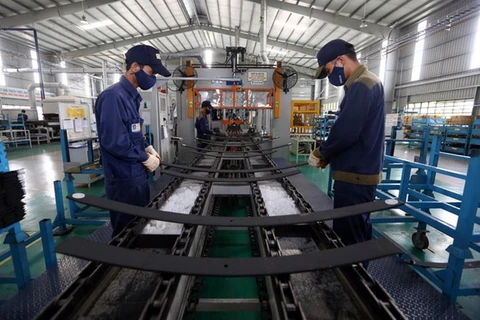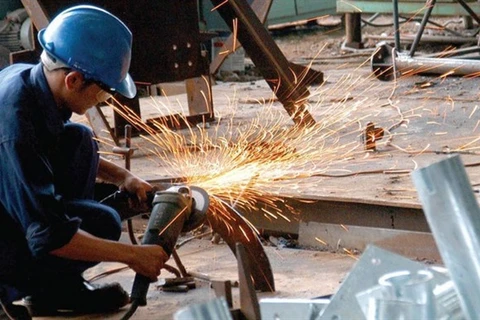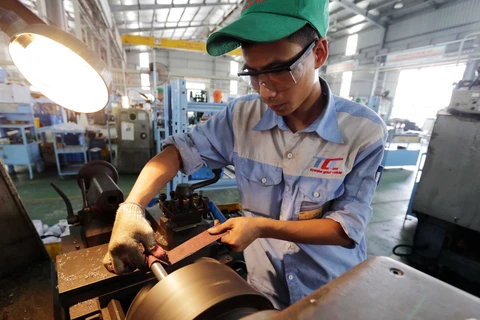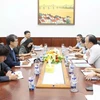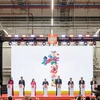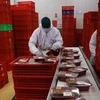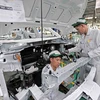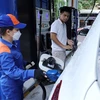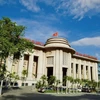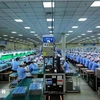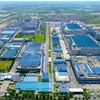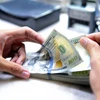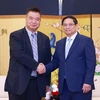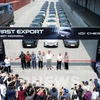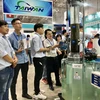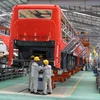Hanoi (VNA) – A huge influx of foreign direct investment (FDI) is making its way into the fields of mechanical engineering, and manufacturing and processing, which are expected to fuel the supporting industry in the coming years if Vietnam issues effective policies, industry insiders have said.
According to the Ministry of Planning and Investment (MPI), foreign investors helped fund 19 out of 21 economic sectors as of the late August – mostly in manufacturing and processing, and mechanical engineering – with 190.56 billion USD, accounting for 57 percent of the total.
Economist Tran Van Tho from Tokyo’s Waseda University said FDI is an effective investment attraction channel if Vietnam issues proper policies, adding that FDI brings along with it technology, capital and governance from major industrial corporations.
He proposed creating favourable conditions for foreign-invested enterprises to improve product quality and hold dialogues with major mechanical engineering firms to encourage business expansion.
Amidst the Fourth Industrial Revolution, it is necessary to attract FDI selectively, with focus on quality rather than quantity, he said.
Vice Chairman and General Secretary of the Vietnam Association of Mechanical Industry Dao Phan Long said most of domestic mechanical engineering firms are still using outdated technologies, while foreign-invested enterprises are yet to form close links with domestic partners.
Recently, many firms from the Japan External Trade Organisation in Ho Chi Minh City plan to switch their manufacturing lines in machinery and metallurgy from China to Vietnam. The trend is forecast to increase in the near future, reported the association.
Deputy head of the MPI’s Department of Industrial Economics Le Thuy Trung urged economic sectors, especially foreign-invested ones, to invest in mechanical engineering. He called for continuing to speed up equitisation and State divestment in State-owned enterprises in mechanical engineering in line with the law.
Economist Tho stressed the need to change strategies on accessing FDI and the world’s technology, encourage joint-ventures, and call for FDI from the world’s most prestigious firms.–VNA
According to the Ministry of Planning and Investment (MPI), foreign investors helped fund 19 out of 21 economic sectors as of the late August – mostly in manufacturing and processing, and mechanical engineering – with 190.56 billion USD, accounting for 57 percent of the total.
Economist Tran Van Tho from Tokyo’s Waseda University said FDI is an effective investment attraction channel if Vietnam issues proper policies, adding that FDI brings along with it technology, capital and governance from major industrial corporations.
He proposed creating favourable conditions for foreign-invested enterprises to improve product quality and hold dialogues with major mechanical engineering firms to encourage business expansion.
Amidst the Fourth Industrial Revolution, it is necessary to attract FDI selectively, with focus on quality rather than quantity, he said.
Vice Chairman and General Secretary of the Vietnam Association of Mechanical Industry Dao Phan Long said most of domestic mechanical engineering firms are still using outdated technologies, while foreign-invested enterprises are yet to form close links with domestic partners.
Recently, many firms from the Japan External Trade Organisation in Ho Chi Minh City plan to switch their manufacturing lines in machinery and metallurgy from China to Vietnam. The trend is forecast to increase in the near future, reported the association.
Deputy head of the MPI’s Department of Industrial Economics Le Thuy Trung urged economic sectors, especially foreign-invested ones, to invest in mechanical engineering. He called for continuing to speed up equitisation and State divestment in State-owned enterprises in mechanical engineering in line with the law.
Economist Tho stressed the need to change strategies on accessing FDI and the world’s technology, encourage joint-ventures, and call for FDI from the world’s most prestigious firms.–VNA
VNA


